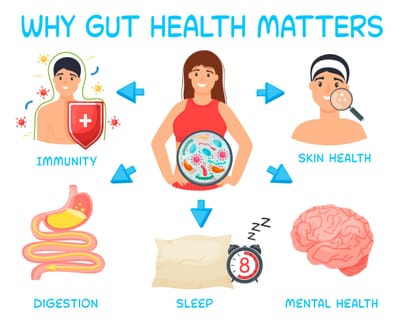On this page
The Paleo Diet, centered around whole, unprocessed foods, naturally supports the body’s detoxification processes. In today’s world, we encounter toxins from the environment, food additives, and even personal care products. The body’s detoxification pathways, primarily located in the liver, work to neutralize and eliminate these toxins through a series of complex biochemical reactions. By emphasizing nutrient-dense foods that provide the building blocks for these pathways, the Paleo Diet aligns seamlessly with the body’s natural ability to detoxify and maintain metabolic health.
How the Paleo Diet Aligns with Natural Detox Pathways
The body detoxifies through three main systems:
- Phase I Detoxification (Activation): This stage involves the transformation of toxins into less harmful metabolites through oxidation, reduction, and hydrolysis reactions. The process creates reactive intermediates, which can be damaging if not neutralized.
- Phase II Detoxification (Conjugation): In this phase, reactive intermediates are converted into water-soluble compounds, making them easier for the body to excrete. This stage relies heavily on nutrients like amino acids, antioxidants, and certain vitamins and minerals.
- Antioxidant Support: Free radicals generated during detoxification are neutralized by antioxidants, protecting cells from oxidative stress. The Paleo Diet naturally provides a range of antioxidants that support this phase.
Key Paleo Foods for Enhanced Detoxification
The Paleo Diet, by focusing on ancestral foods, provides the essential nutrients required for each stage of detoxification:

Cruciferous Vegetables: Powerhouses for Phase I and II
Cruciferous vegetables like broccoli, cauliflower, and Brussels sprouts are rich in compounds such as sulforaphane and indoles, which boost the activity of Phase I enzymes. Sulforaphane, in particular, has been shown to stimulate the cytochrome P450 enzymes that drive Phase I detoxification, preparing toxins for excretion. These vegetables also support Phase II detoxification, helping balance reactive intermediates and preventing oxidative damage.
High-Quality Proteins for Conjugation
The Paleo Diet emphasizes high-quality protein sources such as grass-fed beef, wild-caught fish, and pasture-raised eggs. These proteins supply essential amino acids, including cysteine, glycine, and glutamine, which are vital for producing glutathione—a key antioxidant and detoxification molecule. Glutathione plays a critical role in conjugating toxins during Phase II, neutralizing heavy metals, and supporting immune health.
Leafy Greens for Antioxidant and Methylation Support
Leafy greens, like kale, spinach, and collard greens, are loaded with antioxidants, including vitamins A, C, and K. These antioxidants not only combat oxidative stress during detox but also provide methyl donors (such as folate), which support methylation—a Phase II detox pathway essential for processing hormones and neurotransmitters. Methylation, in turn, helps maintain mental clarity and hormone balance, promoting overall well-being.
Fermented Foods for Gut Health and Detox Support
While not all fermented foods fit strict Paleo guidelines, those that do—such as sauerkraut, kimchi, and coconut yogurt—provide beneficial bacteria that support gut health. A healthy gut microbiome aids detoxification by breaking down toxins and preventing them from re-entering the bloodstream. Incorporating these foods into a Paleo lifestyle enhances the gut’s role in detoxification, supporting better digestion and immune function.

Supporting Antioxidant Pathways with Paleo Foods
The Paleo Diet is rich in antioxidant-dense foods that protect against cellular damage caused by detoxification processes. Several Paleo-friendly foods are known to activate the Nrf2 pathway, a critical cellular defense mechanism:
- Berries: Blueberries, blackberries, and raspberries are high in anthocyanins, powerful antioxidants that protect against oxidative stress and support both detoxification and immune health.
- Green Tea: While more common in primal adaptations of Paleo, green tea’s catechins enhance detoxification enzymes and support liver health.

- Turmeric: A Paleo staple in cooking, turmeric contains curcumin, which supports both Phase II detox pathways and antioxidant production, aiding in the elimination of environmental toxins.
Practical Tips for a Detox-Supportive Paleo Diet
To maximize the detox benefits of a Paleo lifestyle, consider these tips:
- Prioritize Cruciferous Vegetables: Aim to include at least one serving of broccoli, kale, or cauliflower daily to support Phase I and II enzymes.
- Use Herbs and Spices Liberally: Incorporate turmeric, garlic, and ginger into meals. These spices not only add flavor but also provide anti-inflammatory benefits and support liver health.
- Hydrate with Filtered Water: Detoxification requires adequate hydration. Drinking filtered water supports kidney function, helping to flush out water-soluble toxins effectively.
- Include High-Quality Fats: Foods like avocado, coconut oil, and fatty fish supply omega-3 fatty acids, which help combat inflammation and support cellular repair during detoxification.
- Experiment with Intermittent Fasting: Many people on Paleo incorporate intermittent fasting, which can enhance detoxification by allowing the body to focus on repair processes rather than digestion. Short fasting periods, such as 12-16 hours overnight, may support liver function and cellular regeneration.
The Long-Term Benefits of a Paleo Detox Approach
By focusing on foods that enhance natural detoxification pathways, the Paleo Diet not only supports immediate health but also provides long-term benefits:
- Reduced Inflammation: Paleo’s anti-inflammatory food choices decrease the body’s overall toxin load and support clearer skin, better joint health, and a stronger immune system.
- Improved Energy and Mental Clarity: Many Paleo followers report sustained energy and mental focus as the diet’s nutrient-dense foods support stable blood sugar and efficient detoxification.
- Hormone Balance: Paleo’s detox-supportive nutrients aid in the clearance of excess estrogen and other hormones, which can improve mood, metabolic health, and reproductive wellness.
The Paleo Diet offers a sustainable, natural approach to supporting the body’s detoxification pathways. By focusing on high-quality proteins, vegetables, and antioxidant-rich foods, Paleo enhances the liver’s ability to process and eliminate toxins, providing a foundation for lifelong health. Integrating these detox-supportive foods into your daily routine can help your body manage environmental stressors, improve energy, and foster resilience for optimal wellness.
References
- Hodges, R.E., & Minich, D.M. (2015). "Modulation of Metabolic Detoxification Pathways Using Foods and Food-Derived Components." Journal of Nutrition and Metabolism, 2015.
- Zhou, et al. "Sulforaphane in Cruciferous Vegetables and Detoxification Enzyme Induction.










